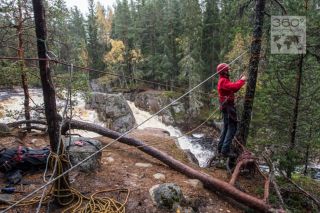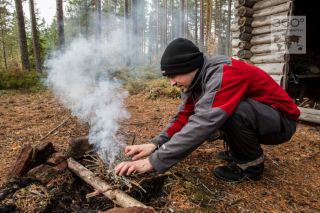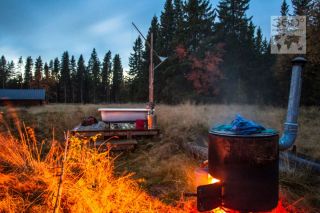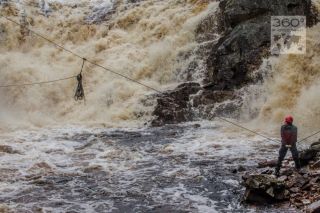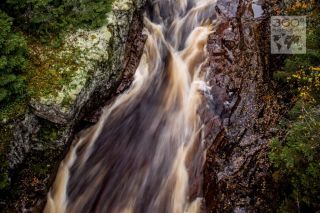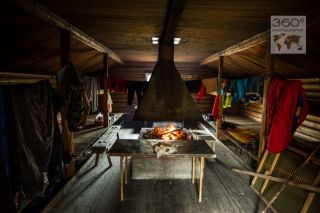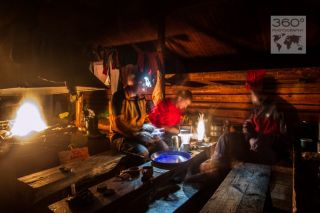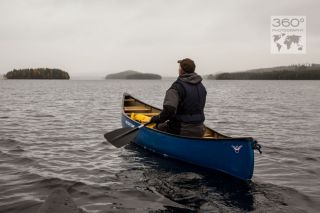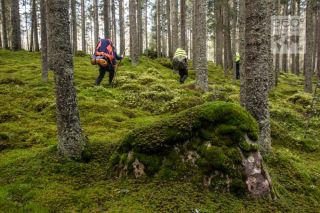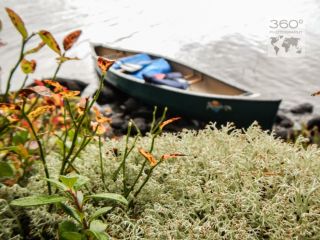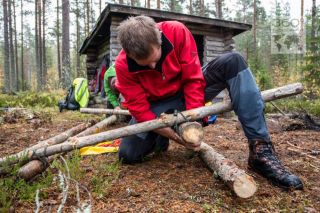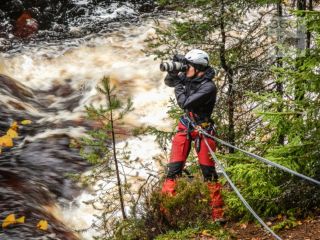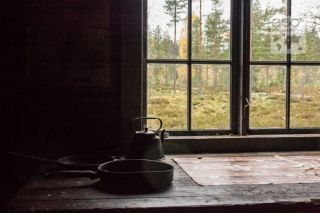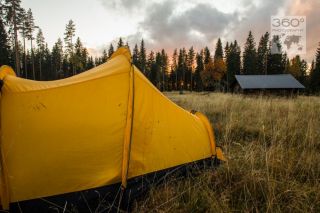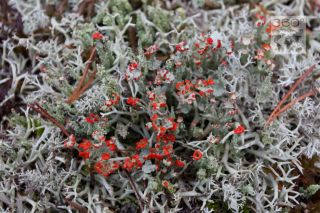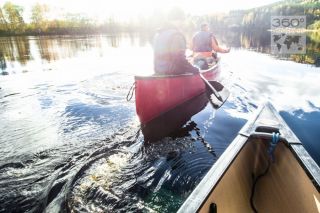Auf Prüfungstour in Värmlands Wildnis
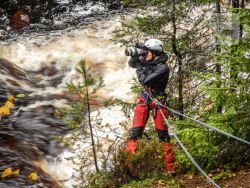
Menschen in der Wildnis zu führen ist eine verantwortungsvolle Aufgabe. Diese dabei nicht zu zerstören sondern genießen zu können ist eine Herausforderung. Enecco Mitglieder Maren Krings (Fotografin) und Peter Jäkel (PJ Erlebnisprofis und Prüfer des Internationalen Wildnisführer Verbandes – IWV) begleiteten die Anwärter des IWV in der heißen Phase auf der Prüfungstour im schwedischen Värmland. Über die Herausforderungen der Tour berichtet Maren Krings.
Text + Fotografie: Maren Krings
Rhythmisch prasseln die Regentropfen auf mein Zelt. Warm liege ich in meinem Daunenschlafsack und lasse mich ins Land der Träume tragen. Dort vermischen sich die bunten Herbstfarben mit meinen Erlebnissen der Prüfungstour. Die klare Herbstluft treibt mich im Kanu über den See Knon, neben mir paddelt Peter Jäkel, Prüfer des IWV. Als sein Kanu umkippt und er vorbildlich von dem Prüfling Constantin aus dem kalten Wasser gezogen wird, ertönen aufgeregte Schreie. Die Stimmen werden immer lauter, ich wache auf. Meine Uhr zeigt 4.00 Uhr morgens an. Die Stimmen sind echt. Die Prüflinge Konstantin, Marcel und Sascha nötigen mich, sofort aus meinem Zelt zu kommen. Schlaftrunken krieche ich hinaus in den Nieselregen. Der Schein der Taschenlampen erhellt die Nacht. Alle sind hektisch beim Abbauen der Zelte und packen der Rucksäcke. Hastig weist Konstantin mich an, selbiges zu tun. Ein Funkspruch hatte ihn vor einigen Minuten erreicht, flussaufwärts sei ein Damm gebrochen und es ist mit einer Überflutung zu rechnen. Nun gilt es unseren Zeltplatz am Fluss Halgån schnellstmöglich zu verlassen und Höhenmeter zu gewinnen. Wir helfen uns gegenseitig und schaffen es somit innerhalb von 17 Minuten marschbereit zu sein. Allmählich werde ich richtig wach und besinne mich, dass eine nächtliche Evakuierung Teil des Prüfungsplans ist. Unsanft stolpern wir durch die Nacht, auf der Suche nach der Åstrandssättern, deren Koordinaten wir bekommen haben. Diese Hüttenansammlung liegt hoch genug, dass uns ein Hochwasser nichts anhaben kann. Es herrscht Uneinigkeit über die Wegwahl, aber dann finden wir den Pfad, der durch unwegsames Gelände in den Wald führt. Nächtlich rau ertönen unsere Rufe, die Elche und Bären vor uns warnen sollen. In dunkler Nacht verzichten wir lieber auf die unerwartete Begegnung mit solchen Riesen! Es dämmert, als wir die Umrisse der Hütten erkennen. Erleichterung zeichnet sich auf den Gesichtern ab, wir haben es geschafft.
Ich kann mir ein breites Grinsen nicht verdrücken, als Jörg Rädel, Prüfer und Ausbildungsleiter, offenbart das es keinen Damm am Halgån Fluss gibt. Es war alles nur ein Prüfungsszenario. Mit einem Augenzwinkern gestehen Jörg und Peter, das normalerweise ein Waldbrand der Grund für die Evakuierung ist. Durch den ausgiebigen Regen der letzten Tage jedoch, wäre dieses Szenario nicht glaubwürdig gewesen und sie hatten eine Stelle außerhalb des mitgeführten Kartenmaterials für den fingierten Dammbruch gewählt.
Als 1986 der IWV gegründet wurde, dauerte die Ausbildung nur zwei Wochen. Viel hat sich seither entwickelt und mit 28 Jahren Outdoor- Erfahrung in der Tasche, werden bald fünf hochwertige Ausbildungen im Outdoorsektor angeboten.
Das Ziel, naturbegeisterten Menschen das Handwerk für den verantwortungsvollen Umgang mit Natur und Umwelt zu geben, musste sich der Entwicklung im Outdoor Bereich immer wieder anpassen. Das System mit sieben Modulen vermittelt praxisorientiertes Wissen im Wildwasser, pädagogischen Grundlagen, medizinischer Notversorgung, mobilen Seilaufbauten, Orientierung, Wetterkunde und vielem mehr.
Die Prüfungstour in Schweden und ein Volontariat beenden die Ausbildung, welche ein bis zwei Jahre dauert.
Die Prüfungstour, im schwedischen Värmland ist ein Highlight der Ausbildung. Die gute Erreichbarkeit und eine abwechslungsreiche Landschaft sind ein Teil, warum die Gegend um Ekshärad ein Eldorado für die Prüfungstour des IWV geworden ist. Die Organisation vor Ort und den Kontakt zu den Einheimischen liefert Peter Jäkel, mit seiner Firma PJ Erlebnis Profis. Seit 20 Jahren ist er geprüfter Wildnisführer, seit 16 Jahren Teil des Lehrteams. Er kennt die Wälder, Canyons, Hochmoore, Seen und Flüsse der Umgebung wie seine eigene Westentasche. Nur er weiß wie die genaue Route verlaufen wird. Er sammelt die Koordinaten, welche die Prüflinge dann, auf ihrer Tour, punkt- orten sollen. Trotz des Jedermannsrecht holt er sich die Erlaubnis von den Waldbesitzern für die Lagerplätze ein. Die große Gastfreundschaft der Värmländer ermöglicht ein ganz besonderes Erlebnis für die Prüfungstour. Wenn man, nach drei Tagen, die Müdigkeit der langen Wanderungen durch Hochmoore und Wälder in den Knochen zu spüren beginnt, endet der Tag auf einer Lichtung bei der Gammelsätern Alm. Skurril thront dort eine Badewanne, umringt von Wald und dem endlos klaren Sternenhimmel Schwedens. Die körpereigenen Kräfte leben auf, wenn das Brunnenwasser im Holzofen für ein Entspannungsbad erwärmt ist. Wohlverdient, denn die sechs Tage fordern geistige und körperliche Höchstleistung von den Prüflingen ab. Gepäck und Verpflegung tragen sie in ihren Rucksäcken. Im Schnitt werden pro Tag 14 Kilometer zu Fuß und mit dem Kanadier zurückgelegt. Das erlernte Wissen in der Praxis anzuwenden, wird jeden Tag getestet. Die Bergung eines umgekippten Kanus und Versorgung von offenen Brüchen und Verbrennungen gehören zu dem inszenierten Programm. Den Rest fordert die Natur selber ein. Abends fertigen die Prüflinge eine Wetterkarte nach ihren Beobachtungen und dem öffentlichen Wetterbericht an. Tag für Tag übernimmt ein Anderer die Aufgabe des Wildnisführers. Eine besondere Herausforderung ist die Querung des Fluss Musån auf einem Floss. Das Gepäck, in Seesäcken verstaut, agiert als Schwimmkörper für die zusammengebundenen Stämme. Spannend wird es, als uns die Koordinaten zum Brattfallet Canyon führen. Hier benötigen wir eine mobile Seilbahn über den Canyon. Unter Anwendung aller erdenklichen Techniken ist es nach drei Stunden geschafft, die Schlucht zu bezwingen. Kindlich ist unsere Freude, als wir in rasantem Höhenflug an der Seilbahn von einer Seite zur Anderen queren. Zwei von drei Prüflingen haben es geschafft und wechseln somit die Seite vom Anwärter zum geprüften Wildnisführer.
Informationen:
PJ Erlebnis Profis: http://www.erlebnis-profis.de
IWV: http://www.wildnisfuehrer.de
360º Photography- Maren Krings: http://www.360-photography-mk.de
Finals to being a certified wilderness guide
Guiding people through wilderness is linked to a lot of responsibilities. Enjoying its beauty and yet not destroying it is a challenge. Enecco member Maren Krings (photographer) and Peter Jäkel (CEO of PJ Erlebnis Profis and examiner for the International Wilderness Guide Association – IWV) were part of the examination week, which took part in Swedish Värmland. Maren Krings wrote about the challenges awaiting the aspiring wilderness guides on this final tour.
Text + photography: Maren Krings
It’s warm and snuggly in my down feather sleeping bag, while the rain patters rhythmically on my tent and carries me away in the land of dreams. There, the colors of autumn get mixed up with my experiences from the tour. I am sitting in a canoe; the cold breeze of autumn- clear wind pushes me over the lake Knon. In the canoe next to me, Peter Jäkel, who is one of two examiners for the Wilderness Guide Association. While he tips over with his canoe, examinee Konstantin pulls him out of the water and screams get louder and louder. I am waking up, while the rescue was a dream, the screams are real! My clock shows it’s 4 am. The three aspirants Sascha, Konstantin and Marcel urge me to quickly get out of my tent. Sleepily I am crawling out into the night, it is still raining. The casts of flashlights are illuminating the night; everybody is already frantically packing together tents, sleeping bags and all their belongings. Konstantin instructs me, to do the same. A radio message had reached him and informed about a broken dam upward the Halgån River. A flooding along the riverbanks and hence also our tent ground, was to be expected soon. We have to win altitude quickly. Already in a good team mode, we manage to get everything packed up and going, within 17 minutes from radio message to hastily hiking off.
I am finally awake enough to remember that an evacuation during nighttime is part of the examination routine. We are stumbling ruggedly through the night. Trying to find the Åstrandssättern, of which we received the coordinates via radio message. There are as many opinions, on how to get there, as people in the group. Eventually only one opinion proves right and we are moving on, still shouting out loud, to warn bears and elks of our approach. None of us is looking forward to an unexpected encounter with either one of these giants during nighttime. As the morning rises, we can make out rooftops, which indicate our arrival at the Åstrandssättern. Relive marks most of our facial expressions. I have to hide the grin on my face, as Jörg Rädel, examiner number two and training manager of IWV, explains that there is no dam along the entire Halgån River, it was just a test. With a wink of his eye he admits, that normally wildfire is the reason for the evacuation, but with all this rain, no one would have believed the radio message, setting off the alarm.
1986, when the IWV was founded, the entire training only took two weeks. A lot has developed since. Twenty- eight years of outdoor experience, helped to establish a professional educational system, consisting of five individual trainings for outdoor activities. Goal is, to instruct nature loving individuals’ skills to responsibly treat nature, while on tour. With the fast development within the outdoor sector, there were a lot of adjustments made, in the last years. The modules “wild water”, “medical emergency supply”, “rope systems” and “educational basics” are some of the newer ones. “Weather” and “orientation” have not changed too much. After finishing these trainings and a voluntary internship with an outdoor company, the examination tour in Sweden can be taken. All together takes about one up to two years.
No question, the final tour to Sweden is one of the highlights of training to be a wilderness guide. Easy accessibility and the diverse landscape are two good reasons for the choice of Ekshärad and the surrounding area. Also Peter Jäkel is running his outdoor business there and hence offers best contacts and location knowledge. Peter is a wilderness guide since 20 years,16 years he has been part of the training team of IWV. He knows the area as his inner vest pocket. Chances of getting lost in the woods, canyons, highmoores, lakes and rivers are slim, when Peter is in charge. And he is!
He is in charge of the coordinates, which have to be located by the aspirants on tour. Even though camping is legal in Scandinavia, due to the “everyone’s right”, (a law, which allows everyone to stay one night in a tent at any place) Peter checks with local landowners, to get special permission, to use some of the most magical spots there are.
One of these locations is the Gammelsätern, a couple of private cottage houses in a forest clearing. Those are of no further interest to us, though a bathtub, which thrones solemnly on the clearing, attracts a lot our interest.
Just as the heavy bag packs start to wear us down, after three days of hiking through the forest, we are arriving at this location. It is simply revitalizing, as the hot water, previously pulled out of the well and heated in the wood oven next to the tub, relaxes each of my tired muscles under the clear Swedish night sky, full of stars.
It’s strenuous to carry all the nutrition and belongings for the 7-day trip as far as 14 kilometers by foot or else in canoes, each day. The physical labor is juxtaposed by the mental stress, posed by nature and the elaborate examinations to be a wilderness guide. Treatment of burns, broken bones or evacuation of an overturned canoe are tasks that need to be handled confidently. Every night, when the fire is going and the tent is set up the aspirants need to draw a weather chart, according to their observations during the day. Each day another one of the three aspirants has to take turn to be the wilderness guide, leading us through the Swedish backcountry, telling us about fauna and flora, animals and other highlights along the way. Every now and then this person even has to instruct the group on building a float, with the bag packs, in order to pass a river, or build up a ropeway, spanning over a deep canyon. The last task happens on our last day of the tour. Two of the three aspirants not only switch from one side of the canyon to the other, but also go from aspirant to a certified wilderness guide. The third, still happy to finish the tour, will have his second chance in a year.
Informations:
PJ Erlebnis Profis: http://www.erlebnis-profis.de
IWV: http://www.wildnisfuehrer.de
360º Photography- Maren Krings: http://www.360-photography-mk.de



 Newsletter
Newsletter
